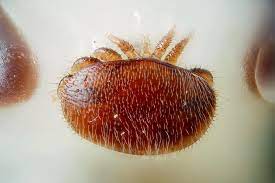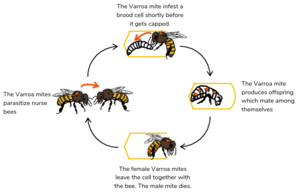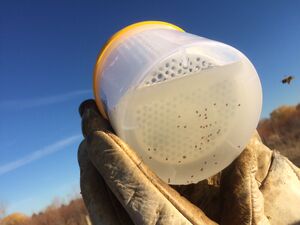Varroa destructor
The Varroa mite or Varroa destructor is the world’s most devastating pest of Apis mellifera, the Western honey bee. As ectoparasites, Varroa destructors attack adult honey bees and their developing larvae, feeding on their fat body tissues. Varroa infestation results in deformation, mortality, and subsequent weakening of the colony which potentially leads to colony death. As the mite can spread quickly from colony to colony, the Varroa destructor is an imminent threat to honey bees. Formerly found only in Asia, Europe, Africa, and South America, the mite has now infiltrated the United States where it is devastating the Western honey bee population.

Taxonomy
Kingdom: Animalia
Phylum: Arthropoda
Class: Arachnida
Order: Mesostigmata
Family: Varroidae
Genus: Varroa
Species: Varroa destructor
Description
Adult Varroa destructors measure 1 to 1.8 mm in length and 1.5 to 2 mm in width. Females are reddish-brown in color and males are yellowish-white. The mites have flattened bodies, enabling them to fit between the body segments of honey bees, where they feed on the bee’s fat bodies and internal fluids. Varroa destructors can be observed with the naked eye and may even be observed attached to adult honey bees [1].
Varroa destructor eggs are oval-shaped and white in color. They are approximately 0.30 mm long and 0.23 mm wide. In general, the eggs cannot be seen by the naked eye [2].


Habitat and Range
The Varroa destructor is an ectoparasite of honey bees, thus residing on them as a parasite. They are usually found on the thorax and abdomens of larvae, pupae, and adult honey bees. The mite affects Asian honey bees, Apis cerana, and European honey bees, Apis mellifera [3].
Varroa destructors can be found all throughout the United States in both wild and managed honey bee colonies [4]. Wherever bee colonies are found, the Varroa destructor is more than likely found as well. Currently, Australia is the only continent that is uninhabited by the mite [3].
Life Cycle
When female Varroa destructors are ready to lay eggs, they insert themselves into brood cells containing young honey bee larvae, just before the cells are capped. The mite will immerse itself into the remaining brood food. After the cells are capped and the larvae have finished spinning cocoons, the Varroa destructor will begin laying eggs. A female mite may lay 4 to 6 eggs. The adult female mite and its offspring will feed and develop on the bee as it matures.
The mite life cycle consists of four developmental stages. These stages are the egg stage, the protonymph stage, the deutonymph stage, and the adult stage. The period from egg to adult lasts about 6 to 7 days for the female and 5 to 6 days for the male. Mating occurs in the brood cells before the new adult female mites emerge. The adult males die after copulation as their mouths are modified for sperm transfer instead of feeding. The old female and the newly-fertilized female offspring remain in the brood cell until the young bee emerges. The adult bee survives as a host and a means of transportation for the female Varroa destructors.
Female Varroa destructors produced in the summer can live 2 to 3 months, whereas those produced in the fall live 5 to 8 months. Without bees and brood, the Varroa destructor can survive no more than 5 days. They can, however, live in a comb with sealed brood for up to 30 days [6].

Impacts on Western honey bees
Honey bees infested with one to two adult Varroa destructors do not have visible signs of damage and can appear to be normal and healthy. However, they may suffer from malnutrition, blood loss, and disease as Varroa destructors are known to transmit a number of pathogens including several viruses. Honey bees that are heavily infested with more than a few adult mites usually become visibly crippled or die in their cells without emerging. Additionally, adult bees heavily infested may become restless and fly with difficulty. Their life span is shorter and they perform tasks poorly.
On a colony level, the symptoms of a Varroa destructor infestation depend upon the degree of infestation. Low-level infestations are difficult to detect as it may not be apparent that the honey bees are infested. Medium-to high-level infestations may result in bees that are heavily impacted with the impacts listed above. Colonies become severely debilitated as mite populations reach extremely high levels at the end of the brood rearing season. This in turn severely affects honey production [6].
Management
Early detection of a Varroa destructor infestation is essential. Many colonies will succumb to Varroa infestations in the late summer or fall. Integrated pest management (IPM) is a method of dealing with pests and parasites that is based on the notion that one cannot chemically eradicate pests or parasites but must continually manage their populations. IPM involves mixing different tactics (mechanical/physical methods, genetic/cultural methods, and chemical treatments) and knowing critical times in the life cycle of the target organisms that make them vulnerable to control methods. Chemicals are only applied when pest populations are above an action or economic threshold. The reduced use of chemicals to control Varroa mites limits possible contamination of hive products and delays resistance development to chemicals by the mites.
A key component of IPM is that decisions to use chemicals for controlling mites is based on sampling (monitoring and identification) of the pest population and only treating when a critical threshold is met. The most convenient methods of sampling varroa mites involve estimating the prevalence of mites on adult honey bees. The prevalence is described as a percentage. The most commonly used non destructive sampling method is the powdered sugar shake. The destructive method involves washing samples of dead bees with alcohol or a soapy water mixture. This is a much more accurate method than the sugar shake.

The powdered sugar roll or sugar shake method provides a means for estimating how many mites are on the bees that are sampled. This method does not kill the bees and revolves around the ability of dust with small particle sizes to dislodge the mites from the adult bees bodies. The small sugar particles create a barrier between honey bee bodies and the mites, which are like small suction cups. When bees are rolled and coated in the sugar, the mites’ feet contact the sugar and they lose their grip.

The alcohol wash method is similar to the sugar shake except the adult bees are killed before measuring the mite load. Honey bees are put in jars with 70 percent ethanol to completely cover them. The jar is then shaken vigorously for several minutes, killing the bees and dislodging the mites for counting. This method is most efficient if mechanical shakers are used for several hours [7].
References
[1] Fellows, C.J., et al. “Varroa Destructor, Varroa Mite (Mesostigmata: Varroidae).” LSU AgCenter, 28 Mar. 2023, www.lsuagcenter.com/profiles/bneely/articles/page1586983998498.
[2] Ellis, James D, and C.M. Zettel Nalen. “Varroa Mite.” Varroa Mite - Varroa Destructor Anderson and Trueman, May 2016, entnemdept.ufl.edu/creatures/misc/bees/varroa_mite.htm.
[3] “Varroa Mite.” Business Queensland, 7 Mar. 2023, www.business.qld.gov.au/industries/farms-fishing-forestry/agriculture/biosecurity/animals/invasive/prohibited/varroa-mite.
[4] Varroa Mites, 2005, canr.udel.edu/maarec/wp-content/uploads/sites/18/2010/03/Diseases_of_Honey_Bees_PM.pdf.
[5] Varroa Mite, 2014, www.tsusinvasives.org/home/database/varroa-destructor.
[6] “Varroa Mites.” Bee Aware, beeaware.org.au/archive-pest/varroa-mites/#ad-image-0. Accessed 9 May 2023.
[7] Harris, Jeff, et al. “Managing Varroa Mites in Honey Bee Colonies.” Https://Pollinators.Msu.Edu/Sites/_pollinators/Assets/File/Mississippi%20State%20Varroa.Pdf, 7 Apr. 2023, pollinators.msu.edu/.